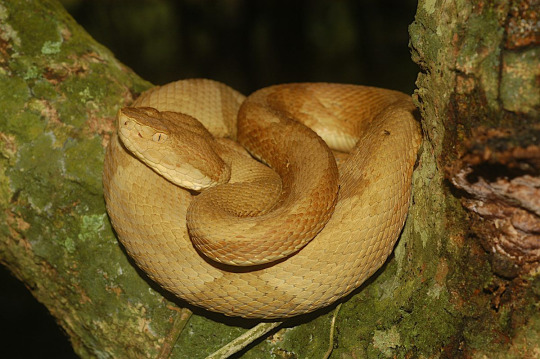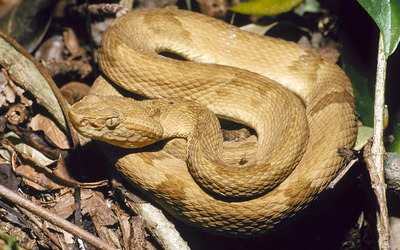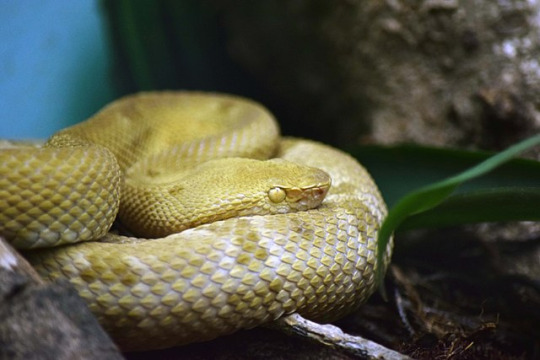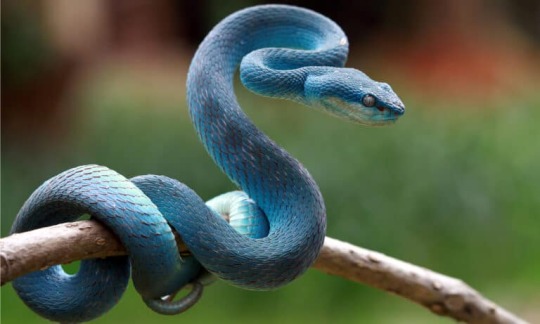#bothrops insularis
Note
About the question you answered six days ago about touching venom, umm, what about the Golden Lancehead? You know the snake species that live exclusively on an island called “Ilha da Queimada Grande” and is quarantined by the Brazilian Navy?
Golden lanceheads (Bothrops insularis) are not an exception to the rule that venom will not hurt you if it only gets on your skin (no snakes are). In fact, because golden lanceheads live exclusively on an island uninhabited by humans, there are no official reports of people being bitten by them. Bothrops in general is a genus that has venom that can be very deadly for humans, but golden lancehead venom is not especially strange for its genus.
The island where golden lanceheads live is quarantined for two reasons, neither of which have to do with the snakes' venom being unusually potent:
The island is biologically isolated, and golden lanceheads have a relatively large population for such a small island. It's estimated that about 2000-4000 lanceheads live on the island, mostly concentrated to rainforested regions, and human presence on the island might result in contact with the snakes. Any area with a known, concentrated population of venomous snakes is likely to have restricted public access.
Golden lanceheads are critically endangered. That population is all there is, and they are at extreme risk from human persecution.
The island is kept in quarantine mostly to protect the snakes, not the other way around.

227 notes
·
View notes
Text

Golden Lancehead (Bothrops insularis), family Viperidae, endemic to Ilha da Queimada Grande, Brazil
Venomous.
Photograph by Ko Biet
211 notes
·
View notes
Text
Queimada Grande Island

Queimada Grande is an island in Brazil that is best known as the Island of Snakes. People are prohibited to go to this island, it's closed to the public, for the protection of both humans and the snakes.
At first I thought, well, Webster is a golden lancehead (bothrops insularis), which is the only venomous snake species that is naturally occurring on that island, they don't exist anywhere else in the world (except for venomous collections, and even then, probably only labs are allowed to house them, I'm not quite sure). His markings do suggest he's a golden lancehead or at least likely of the genus bothrops.
But if we're to take this theory literally, it could be an indicator that Snake's snakes and himself were born in a facility on that island, regardless if they're golden lanceheads or king cobras. It's quite convenient if you're conducting top secret research or don't want to be bothered, to be on an island that was previously thought to have, by some estimates, one (very venomous) snake per square meter and about 430,000 snakes roaming around in total.
Whether it's indeed "Moreau's" island or simply that Webster is a golden lancehead, it's interesting either way.
#kuroshitsuji#black butler#snake#theory#island of dr moreau theory#Snake is a snake#black butler snake#kuroshitsuji snake
52 notes
·
View notes
Text
Classification of Venomous Snakes

Classification of venomous snakes and comprehensive information on snake bites, first aid, treatment, and prevention: (in alphabetical order)
Acanthophis antarcticus (Common Death Adder)
Agkistrodon bilineatus (Mexican Cantil)
Agkistrodon contortrix (Copperhead)
Agkistrodon laticinctus (Broad Banded Copperhead)
Agkistrodon piscivorus (Cottonmouth)
Agkistrodon taylori (Castellana)
Ahaetulla nasuta (Long Nosed Whip Snake)
Aipysurus apraefrontalis (Short-Nosed Sea Snake) - true sea snake; Timor Sea; inhabits shallow coral reef waters;
Aipysurus duboisii (Dubois' Sea Snake) - slightly aggressive; true sea snake; north of Australia and parts of southwestern Pacific Ocean; inhabits shallow reef waters and sandy bottoms;
Aipysurus eydouxii (Spine-Tailed Sea Snake) - not easily provoked; true sea snake; north of Australia and around tropical islands of Southeastern Asia; inhabits shallow bay waters and muddy estuarine bottoms;
Aipysurus foliosquama (Leaf-Scaled Sea Snake) - true sea snake; Timor Sea; inhabits shallow coral reef waters and seagrass bottoms;
Aipysurus fuscus (Dusky Sea Snake) - true sea snake; Timor Sea and Java Sea; inhabits shallow reef waters and sandy sea bottoms;
Aipysurus laevis (Olive Brown Sea Snake) - highly venomous and inquisitive; true sea snake; north of Australia and southwestern Pacific Ocean; inhabits coral reef waters;
Aipysurus pooleorum (Shark Bay Sea Snake) - highly venomous; true sea snake; Shark Bay, west of Australia; inhabits limestone reefs, seabed, and seagrass floor;
Amphiesma stolatum (Buff Striped Keelback)
Aspidelaps lubricus (Cape Coral Snake)
Aspidelaps scutatus (Shield Nose Snake)
Atheris squamigera (African Bush Viper)
Atractaspis bibronii (Bibron's Burrowing Asp)
Atractaspis dahomeyensis (Dahomey Burrowing Asp)
Atractaspis engaddensis (Palestinian Mole Viper)
Atractaspis microlepidota (Small Scaled Burrowing Asp)
Atropoides picadoi (Picado's Jumping Pitviper)
Austrelaps superbus (Lowland Copperhead)
Azemiops feae (Fea's Viper)
Bitis arietans (Puff Adder)
Bitis atropos (Cape Mountain Adder)
Bitis caudalis (Horned Puff Adder)
Bitis cornuta (Western Many Horned Adder)
Bitis gabonica (Central African Gaboon Viper)
Bitis nasicornis (Rhinoceros Viper)
Bitis parviocula (Ethiopian Mountain Adder)
Bitis rhinoceros (West African Gaboon Viper)
Boiga cyanea (Green Cat Snake)
Boiga dendrophila (Mangrove Snake)
Boiga irregularis (Brown Tree Snake)
Bothriechis lateralis (Side Striped Palm Viper)
Bothriechis nigroviridis (Black Speckled Palm Pitviper)
Bothriechis schlegelii (Eyelash Palm Pitviper)
Bothrops alternatus (Urutú)
Bothrops asper (Terciopelo)
Bothrops atrox (Common Lancehead)
Bothrops ayerbei (Ayerbe's Lancehead)
Bothrops caribbaeus (Saint Lucia Lancehead)
Bothrops cotiara (Cotiara)
Bothrops diporus (Chaco Lancehead)
Bothrops erythromelas (Caatinga Lancehead)
Bothrops fonsecai (Fonseca's Lancehead)
Bothrops insularis (Golden Lancehead Viper)
Bothrops itapetiningae (São Paulo Lancehead)
Bothrops jararaca (Jararaca)
Bothrops jararacussu (Jararacussu)
Bothrops lanceolatus (Martinique Lancehead)
Bothrops leucurus (Whitetail Lancehead)
Bothrops mattogrossensis (Mato Grosso Lanzenotter)
Bothrops moojeni (Brazilian Lancehead)
Bothrops neuwiedi (Neuwied's Lancehead)
Bothrops pauloensis (Black Faced Lancehead)
Bothrops taeniatus (Speckled Forest Pitviper)
Bungarus caeruleus (Indian Krait)
Bungarus candidus (Blue Krait)
Bungarus fasciatus (Banded Krait)
Bungarus flaviceps (Red Headed Krait)
Bungarus multicinctus (Many Banded Krait)
Calloselasma rhodostoma (Malayan Pitviper) - highly venomous and irritable; Southeastern Asia; terrestrial and usually nocturnal; often found near agricultural lands;
Causus rhombeatus (Common Night Adder)
Cerastes cerastes (Horned Viper)
Cerastes gasperettii (Arabian Horned Viper)
Cerastes vipera (Sahara Sand Viper)
Cerrophidion godmani (Godman's Montane Pitviper)
Cerrophidion sasai (Costa Rica Montane Pitviper)
Here is the full list of Venomous Snakes. https://www.dovemed.com/classification-disorders-and-tumors/classification-venomous-snakes/
#snake#snakes#lancehead#viper#venomoussnakes#classification#firstaid#health#who#worldhealthorganization#cobra#southamerica#asia#europe
10 notes
·
View notes
Text
Golden Lancehead

Bothrops insularis

🔔 It is a highly venomous pit viper species endemic to Ilha da Queimada Grande, also known as Snake Island, off the coast of Brazil. The species is named for the light yellowish-brown color of its underside and for its head shape that is characteristic of the genus Bothrops.
0 notes
Photo

Golden Lancehead with Color Pencils
#golden lancehead#snakes#Bothrops insularis#Reptiles#pitvipers#sketching#sketch#sketches#pencil sketch#pencil#how to draw#how to sketch
1 note
·
View note
Photo

bothrops insularis -- Golden Lancehead
#hotline#manny pardo#detective pardo#aesthetic#my art#snakes#pardo#stuhff and thangs#if you squint really hard
57 notes
·
View notes
Text
If this was an intentional pun then I am very amused

Martins et al. (2008) presented evidence that the removal of Bothrops insularis from its insular habitat is responsible for the species’ population decline, and found that there were people at the Santos city harbour willing to pay U$30.000 for an individual – Laina et al., 2021
0 notes
Text
Snake Island
Ilha de Queimada Grande, nicknamed Snake Island, is a 430,000-square-meter (110-section of land) island off the bank of the territory of São Paulo, Brazil. It is home to a types of fer-de-spear, the Golden Lancehead Viper (Bothrops insularis), which is quite possibly the most venomous snakes on the planet, nearby legend claims there are five snakes to each square meter, while a narrative on the Discovery Channel says that in certain spots there are upwards of one snake for every square meter. The Golden Lancehead is the lone types of snake on the island, yet is considered at risk for elimination since it has no other territory and may be cleared out by fierce blaze. The snake populace is likewise in danger from inbreeding, impacts of which are obvious in the populace.

Plans to assemble a banana estate on the island failed, however this is likely the cause of the island's name, as in Portuguese, queimada is a name for a slice and-consume fire (i.e., to clear land for agribusiness); thus, the island's name would signify "the island of the large land-clearing fire." For quite a while, the island's just occupant was a beacon guardian. At present, the Brazilian Navy forbids regular people from the island, however researchers here and there get waivers.[1]
The Italian film Burn! (Italian title: Queimada) featuring Marlon Brando happens on a Portuguese island settlement called Queimada; in the film, notwithstanding, the island is a sugar manor which is essential for the Antilles. The story related is reminiscent of the French archipelago of Guadaloupe.
0 notes
Photo




13) Bothrops insularis – Żararaka wyspowa - gatunek węża tak wyjątkowy, że dostał własną wyspę. Dosłownie. Ilha da Queimada Grande u wybrzeży Brazylii liczy dokładnie 0 mieszkańców i to właśnie ze względu na kilkutysięczną populację śmiertelnie jadowitych dla człowieka żararak. Ze względu na całkowity brak ssaków, te piękne węże żywią się ptakami. I tak jakby zwykły jadowity wąż nie był dostatecznie niebezpieczny, ten dodatkowo potrafi rzucić się na ofiarę, będąc na gałęzi kilka metrów wyżej. No, to kto ze mną rezerwuje bilet lotniczy na Ilha da Queimada Grande?
0 notes
Note
So how’d Ilha da Queimada Grande, Brazils snake island get like that?
Oh, I know about the "snake island!" It's a very important name in snake conservation, it's the only habitat for Bothrops insularis, a critically endangered viper. There are estimated to be only about 2500 individuals left in the wild, and the fact they're only found on the island means that breed-and-release programs are difficult because the island can't support a large population.

The guess for what happened at the island is that rising ocean levels cut it off from the mainland of Brazil, and when that happened, the snake population was trapped there. Because of this, they were able to adapt perfectly to the island and spread so that there's a very high percentage of them per square foot on the island. They basically just established themselves as the dominant species.
I will say, though, that the island's reputation is due more to the highly toxic venom of these snakes than their actual number. No fatalities have ever been reported, but that's just because no people have lived on the island since we started keeping record of these things, and it's now closed to the public. The snake population was estimated to be over 100,000 times higher than it actually is, and the small number of snakes actually living on the island is cause for concern.
38 notes
·
View notes
Text
Snake Island—The World's Deadliest Island
There are areas built to be left alone, untouched. What would you do if you wished to protect a place? Do you want to put a fence around that? Perhaps some dogs want to guard it? And if I tell you that mother nature has her ways of protecting a place like an island too? Today's write up we'll talk about one of the world's most dangerous places: Ilha da Queirmada Grande, also known abroad as the Snake Island.
Queimada Grande-The Island of the Snake
From the ocean, 90 miles off Sao Paulo, Brazil, Queimada Grande looks like an ordinary, beautiful island. A slice of paradise halfway through the Atlantic Ocean. But this is just an illusion. Despite the natural beauty, this island is not a holiday or adventure destination. Currently, it is one of the earth's most dangerous areas.
Let's bring these together. Firstly, it's a remote island, secondly, there are no beaches you can drop off, and thirdly, it's packed with Golden Lancehead snakes, endemic to this island (yes, this species, one of the most poisonous in the world, you'll only find there).
Yeah, when is the ending? If you ask me, stay away from this island is an obvious and palpable one! “.
The large population of dangerous snakes has made coexistence on the same island difficult for humans. The Brazilian government is strictly monitoring visits to Queimada Grande Island, due to the risk. This island is so dangerous that the Brazilian navy has prohibited even people to land there.
Yet, how is it dangerous?
Let's talk first of the snake population. Researchers say between one and five snakes per square meter live on the island, which is the largest concentration of venomous snakes anywhere in the world.
And before you start thinking about the chances of getting bitten, you need to know that the effects of lancehead envenomations include swelling, local pain, nausea and vomiting, blood blisters, bruising, vomit, and urinary blood, intestinal bleeding, kidney failure, brain hemorrhage, and severe muscle tissue necrosis, yikes!
Profile of a Snake
The Bothrops Insularis, commonly referred to as the golden lancehead, is a venomous pitviper named for its underside, light yellowish-brown color, and head shape.
They prefer to live on the trees, as opposed to their cousins on the mainland, the Bothrops jararaca, who are responsible for most deaths from snakes in Brazil.
The snake developed a powerful fast-acting poison because of the need to kill birds as quickly as possible (they don't want their prayers to go far after bitten). The result of this evolution is venom five times stronger than that of its cousin on the mainland which can kill a man in an hour.
How did it come about?
In the beginning, this island, aging 55 million years, was connected to the mainland. But it became an island, separate from the continent, after the deglaciation (10 to 12 thousand years ago)
The snakes took over the island, without predators. But with the scarcity of food, these vipers, who were originally living on the ground, had to adapt and learn how to climb trees to get migratory birds to stop there to rest.
How did it come about?
In the beginning, this island, aging 55 million years, was connected to the mainland. But it became an island, separate from the continent, after the deglaciation (10 to 12 thousand years ago)
The snakes took over the island, without predators. But with the scarcity of food, these vipers, who were originally living on the ground, had to adapt and learn how to climb trees to get migratory birds to stop there to rest.
What is Numbers About?
People who went there in the 1900s used to say that it was common to see snakes everywhere, whenever. Nowadays, due in part to bio-piracy, it is not that easy to see as before. It is estimated that the population of the snake fell to about 2 thousand, though this is still an impressive number for such a small island (43 hectares).
The snake has been labeled critically endangered on the IUCN Red List of Threatened Species because of the overall low population of the Golden Lancehead. It was also placed on the endangered Brazilian animal list.
Final comments
You can try going there unless you feel lucky, adventurous, and don't mind more than two thousand pairs of intimidating eyes lurking where you're walking. Be conscious, however, that the island isn't open to tourists, the Brazilian government offers licenses for research and other associated civic activities. But if I were you, I would certainly listen to the advice of Mother Nature and stay away from that island
Read the full article
0 notes
Video
'You're going to die screaming': Inside the rock dubbed 'Snake Island' where 4000 of the world's deadliest serpents live – and their venom can MELT flesh
Golden lancehead vipers cover island in Brazil, with the snake's venom lethal
Unless given authority, access is banned, with close to 4000 snakes on island
60 minutes reporter Tara Brown was a recent visitor, armed with a medical crew
Golden lancehead vipers said to be one of the most poisonous snakes in world
By ANDREW PRENTICE FOR DAILY MAIL AUSTRALIA
PUBLISHED: 15:12 GMT, 24 March 2019 | UPDATED: 15:25 GMT, 24 March 2019
Snake Island is no tourist destination - as reporter Tara Brown discovered recently.
The 60 Minutes journalist and her team were the first Australian media allowed onto the island, which is located 33km off the coast of Brazil near Sao Paulo.
Snake Island is so dangerous, humans are actually forbidden from going there.
As the name suggests, it is absolutely swarming with snakes. And if that wasn't terrifying enough, not just any snakes: golden lancehead vipers, which boast venom so potent it can melt flesh.
An estimated 4000 of the deadly creatures call the island home, and when they are hungry, the locals pluck birds out the sky to feast on.
Snake Island is located 33km off the coast of Brazil near Sao Paulo and is teeming with the world's deadliest serpent
The golden lancehead viper (pictured) has a venom so strong it is capable of burning flesh
Local authorities give permission to only a select few scientists to visit Snake Island each year, and Brown, armed with a team full of medical experts, was recently given the green light.
'I'm always excited about adventure and new destinations and this was sold as a pretty exciting one, and a unique opportunity to see a special habitat that's highly protected,' Brown told news.com.au.
'When we're speaking to local fisherman, they told us, 'That's not a good idea, you don't want to go there'. There are legends about a whole family being killed there, and of pirates burying treasure on the island and the snakes being put there to protect the treasure.'
Bryan Fry, a leading Australian molecular biologist, also warned Brown of the perils of such a trip.
'With these snakes it will be a particularly painful death. You're going to die screaming,' he said, before eventually joining her on the once in a lifetime journey.
Humans are banned from entering Snake Island (pictured) in Brazil for their own safety
Brown and her team were the first Australian media to step foot on Snake Island, which is formally named Ilha da Queimada Grande.
With an estimated three-five golden lanceheads per square metre on Snake Island, Brown and her crew had to keep focused as they made their way deep into the rainforest.
The vipers on Snake Island are a unique species. When sea levels rose 11,000 years ago and cut them off from the mainland, they evolved differently.
'They are different to their mainland cousins in that they are five times more venomous and they are among the top 10 most poisonous snakes in the world,' Brown said.
'Their venom is also more potent because their prey is bigger. It gives everyone a chance to see evolution at play.'
Dr Fry and his team of experts displayed nerves of steel as they milked the deadly vipers for their venom, helping produce much needed anti-venom.
Apart from approved scientists, the only other thrill-seekers bold enough to visit Snake Island are illegal poachers, who can fetch $30,000 a snake - although one wrong move can have fatal consequences.
THE GOLDEN LANCEHEAD VIPER
*Ilha de Queimada Granda in Brazil is the only place in the world where Bothrops insularis, also known as the golden lancehead viper, can be found
*The species has a light yellowish brown colour on its underside
*It grows to an average length of 28 inches (70cm) but can reach a maximum of 46 inches (118cm).
*Its venom can eat flesh and tissue, making prey easier to swallow, while a neurotoxin kills the prey
*Its diet consists mostly of birds, although it has been reported to eat lizards and even cannibalise on other snakes
'With these snakes it will be a particularly painful death. You're going to die screaming,' a leading expert said
Share or comment on this article: Inside the forbidden rock dubbed ‘#Snake_Island’ where 4000 of the world’s deadliest serpents live
#world.s_deadliest_serpents
#online
0 notes
Link
Θα τολμούσατε ποτέ να επισκεφτείτε το «νησί των φιδιών» -όπως είναι γνωστό το Ilha da Queimada Grande- στα ανοικτά των ακτών της Βραζιλίας στον Ατλαντικό Ωκεανό;
Πριν βιαστείτε να απαντήσετε, αφήστε σε δεύτερη μοίρα την ομορφιά του και εξετάστε τους λόγους για τους οποίους αν και απίστευτου κάλλους, το μέρος αυτό δεν έχει ούτε έναν κάτοικο…
Το νησί αυτό έχει συνδέσει το όνομά του με μία από της πιο βασανιστικές μορφές θανάτου: Το τσίμπημα του δηλητηριώδους φιδιού.
Για την ακρίβεια, το τσίμπημα του πιο δηλητηριώδους φιδιού στον κόσμο. Αυτό του υπό εξαφάνιση Bothrops Insularis ή αλλιώς Golden Lancehead (Χρυσός Βόθρακας).
Το Snake Island της Βραζιλίας, αποτελεί μέρος της Πολιτείας του Σάο Πάολο και απέχει μόλις 33 km από αυτό.
Έχει έκταση 430.000 τ.μ και φημίζεται για την επικινδυνότητά του, καθώς κατακλύζεται από επιθετικά χρυσά φίδια – τους χρυσούς βόθρακες- των οποίων το δηλητήριο όχι απλά παραλύει και σκοτώνει όποιον έχει την ατυχία να το δεχθεί στον οργανισμό του, καταστρέφοντας πρώτα όλα τα ζωτικά του όργανα, μα έχει την ιδιότητα να «λιώνει» τη σάρκα του θύματος, ως «σφραγίδα» της επίθεσης του Golden Lancehead. Λέγεται, μάλιστα, πως σπανίως θα επιτεθεί ένα φίδι ολομόναχο στο θύμα.
Ένα από τα πιο χαρακτηριστικά περιστατικά μαζικής επίθεσης των φιδιών, αποτελεί η οικογένεια του τελευταίου φαροφύλακα του Ilha da Queimada Grande.
Σύμφωνα με τον θρύλο, τα μέλη των κορμιών τους βρέθηκαν διάσπαρτα στην έκταση του νησιού, ενώ φημολογείται πως αναγκάστηκαν να εγκαταλείψουν το σπίτι τους όταν οι «χρυσοί επισκέπτες» εισέβαλλαν σ’ αυτό και ξεκίνησαν την επίθεση. Η οικογένεια βγήκε τρέχοντας από το σπίτι, με αποτέλεσμα να βρει φρικτό θάνατο. Έναν θάνατο, όμως, που δεν θα απέφευγε ακόμα κι αν κλειδωνόταν στους τέσσερις τοίχους.
Τα εν λόγω ερπετά μήκους από 70 έως 118 εκατοστά εγκλωβίστηκαν στο νησί όταν η στάθμη του νερού της θάλασσας ανέβηκε, κλείνοντας τον δρόμο που συνέδεε το νησί με την ηπειρωτική χώρα.
Τότε, αναγκάστηκαν να προσαρμοστούν στο περιβάλλον που θα γινόταν το μόνιμο σπίτι τους και να αφήσουν εκτός κάθε «εισβολέα».
Τα σπανιότατα αυτά φίδια –που πλέον αποτελούν προστατευόμενο είδος- αναπαρήχθησαν με ταχείς ρυθμούς και κατάφεραν κυριολεκτικά να κατακλύσουν το νησί σε ελάχιστο χρόνο, προκαλώντας τεράστια ζημιά στα πτηνά της περιοχής. Ο λόγος; Κάτι έπρεπε να φάνε. Και τα πουλιά του τροπικού δάσους του Ilha da Queimada Grande ήταν η ιδανική επιλογή.
Ωστόσο, δεν διστάζουν να τραφούν ακόμη και το ένα με το άλλο όταν υπάρξει ανάγκη, με τα φαινόμενα κανιβαλισμού μεταξύ τους να είναι αρκετά.
Τα Bothrops insularis δεν είναι τα μοναδικά ερπετά που θα βρει κανείς στο νησί, καθώς έχουν παρατηρηθεί και άλλα φίδια -του γένους Dipsas albifrons- στην έκτασή του, που όμως δεν είναι δηλητηριώδη.
Σύμφωνα με τις πρώτες εκτιμήσεις, σε κάθε τετραγωνικό μέτρο του νησιού αντιστοιχούσε και ένα φίδι, πράγμα που σημαίνει ότι στο Snake Island ζούσαν περίπου 430.000 φίδια.
Σύγχρονες έρευνες, κατέληξαν στο συμπέρασμα πως ο πληθυσμός των υπό εξαφάνιση αυτών χρυσών φιδιών δεν ξεπερνά τις 4.000, γεγονός που ανησυχεί τρομερά τους ερευνητές.
Δυστυχώς, η κυβέρνηση δεν έχει καταφέρει να πατάξει αποτελεσματικά την εμφάνιση μαυραγοριτών στα εδάφη του νησιού, οι οποία αιχμαλωτίζουν τα σπάνια ερπετά και τα πουλούν παράνομα έναντι διόλου ευκαταφρόνητων ποσών.
Ένας που τους λόγους που οι χρυσοί βόθρακες είναι τόσο περιζήτητοι, είναι η μοναδικότητα του δηλητηρίου τους.
Παρά το γεγονός πως αποδεικνύεται θανατηφόρο, οι επιστήμονες θεωρούν πως έχει αντικαρκινικές ιδιότητες και πως με τη σωστή επεξεργασία μπορεί να βοηθήσει στα αιματολογικά προβλήματα και τις καρδιακές παθήσεις.
Παρά το γεγονός πως ο πληθυσμός των φιδιών δεν είναι αυτός που είχε αρχικά υπολογιστεί, η ανθρώπινη παρουσία στα εδάφη του έχει απαγορευτεί βάσει νόμου από την κυβέρνηση της Βραζιλίας.
Το είδος αυτό είναι τρομερά επιθετικό και άκρως επικίνδυνο αφού κανείς δεν επιβιώνει αν προσβληθεί από το δηλητήριό τους.
Οι μοναδικοί που έχουν πρόσβαση εκεί είναι τα μέλη του Πολεμικού Ναυτικού της Βραζιλίας, που επισκέπτονται το νησί για τη φροντίδα του αυτόνομου φάρου που χτίστηκε το 1909 και εξειδικευμένοι ερευνητές που φτάνουν στο νησί – φαινόμενο για λόγους επιστημονικής έρευνας –κυρίως για φαρμακευτικούς σκοπούς-, μία φορά το χρόνο.
Μέχρι σήμερα, το Ilha da Queimada Grande θεωρείται ένα από τα πιο απαγορευμένα μέρη του κόσμου, που όμως φημίζεται για την ιστορία και την ιδιαιτερότητά του…
menshouse.gr
Πηγή: http://ift.tt/2wap8LM
http://ift.tt/2waJgO4
0 notes
Text
Cloning and expression of calglandulin, a new EF-hand protein from the venom glands of Bothrops insularis snak
http://dlvr.it/N1cbjS
0 notes
